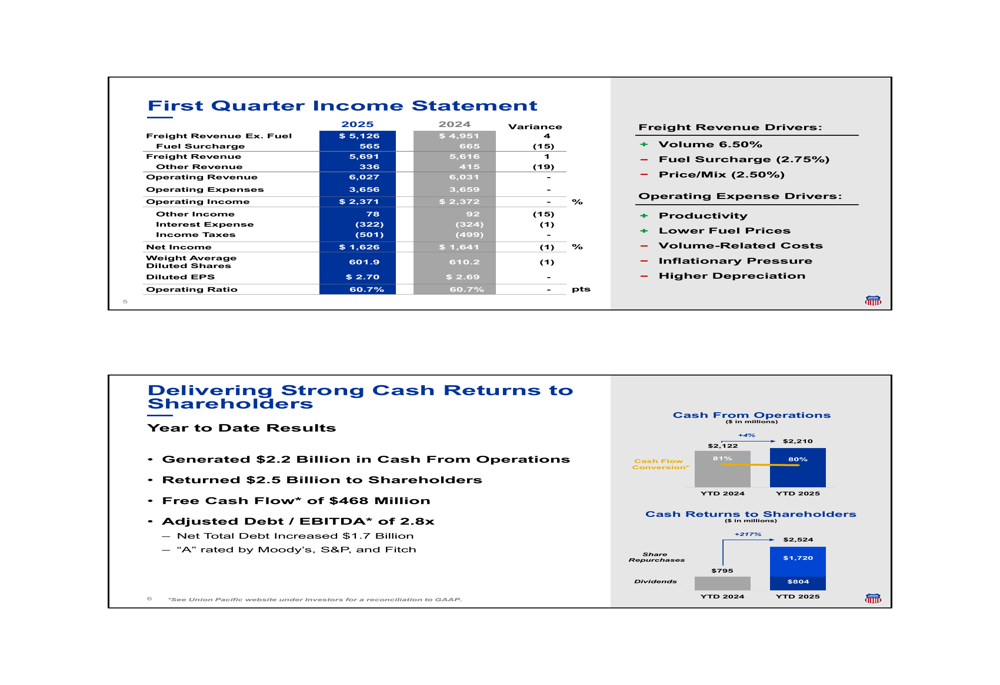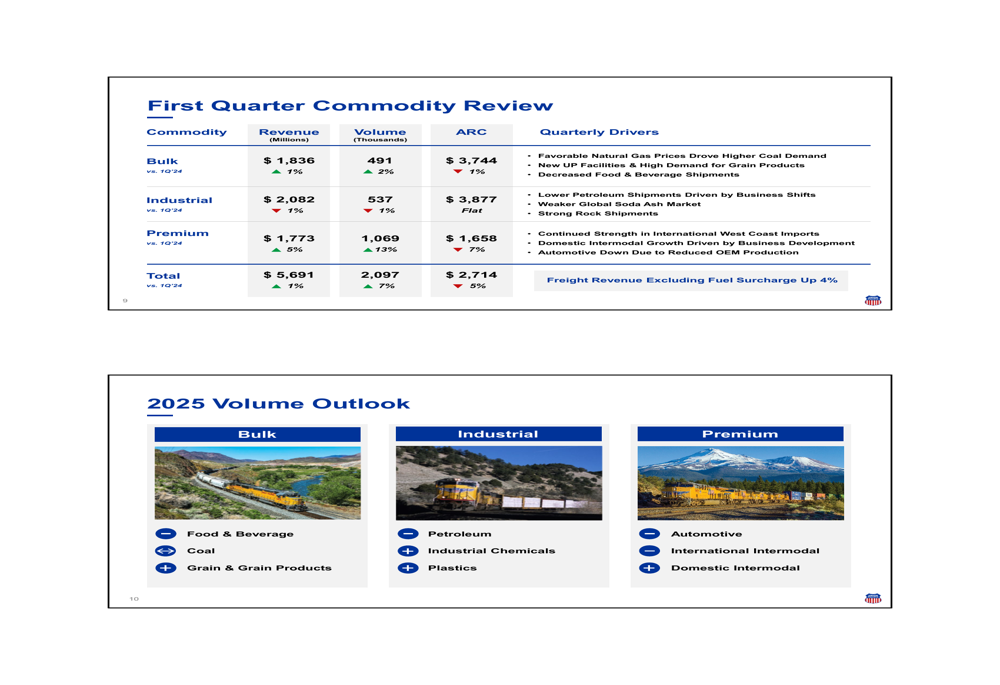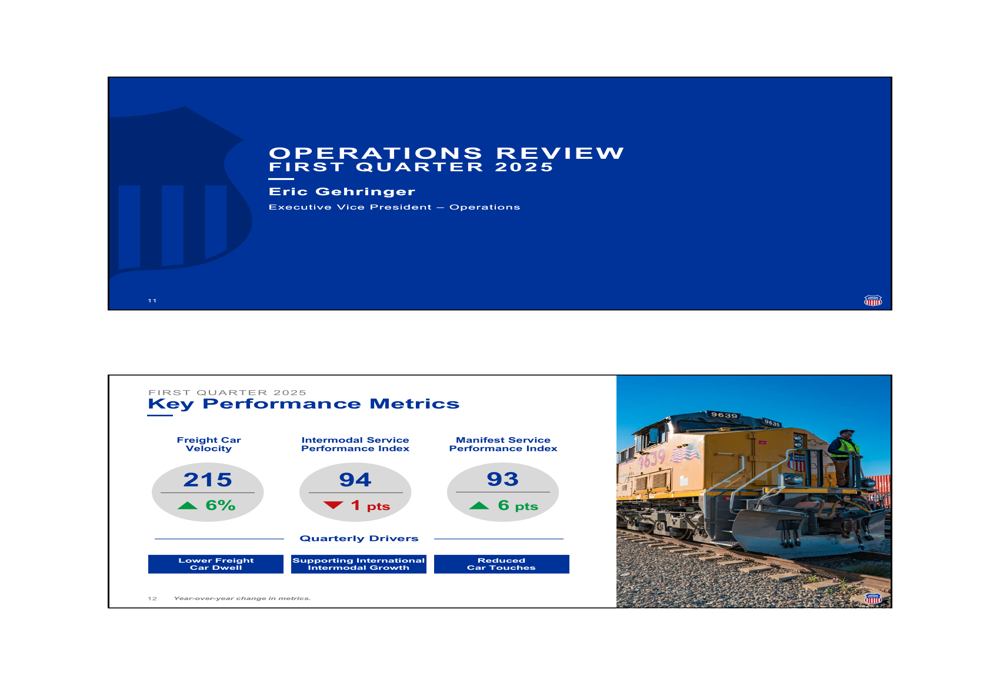Bitcoin price today: dips below $109k as recovery stalls, "Uptober" cheer fizzles
Union Pacific Corporation (NYSE:UNP) reported first-quarter 2025 earnings on April 24, showing modest earnings growth despite facing headwinds from lower fuel surcharges and leap year impacts. The railroad operator maintained its operating ratio at 60.7% while increasing its cash returns to shareholders significantly compared to the prior year.
Quarterly Performance Highlights
Union Pacific achieved earnings per share of $2.70 in Q1 2025, slightly above the $2.69 reported in the same period last year. The company generated operating income of $2.4 billion and net income of $1.6 billion, down 1% year-over-year. Total (EPA:TTEF) operating revenue remained essentially flat at $6.03 billion.
As shown in the executive summary, the company highlighted improvements in operational metrics, with freight car velocity increasing 6% and workforce productivity rising 9% compared to Q1 2024.

The railroad’s performance was supported by strong volume growth, particularly in its Premium segment, which includes automotive and intermodal shipments. However, this was partially offset by lower average revenue per car and reduced fuel surcharge revenue.
Detailed Financial Analysis
Union Pacific’s first quarter income statement reveals the mixed financial picture. While freight revenue excluding fuel surcharge grew by 4%, a 15% decline in fuel surcharge revenue limited overall freight revenue growth to just 1%. Other revenue declined by 19%, resulting in flat total operating revenue compared to Q1 2024.

The commodity breakdown shows significant volume variations across business segments. Premium volumes led the way with 13% growth, driving a 5% revenue increase in that segment. Bulk commodities saw modest 2% volume growth and 1% revenue growth, while Industrial volumes and revenue both declined slightly.

On the shareholder return front, Union Pacific significantly increased its cash returns to shareholders in Q1 2025. The company returned $2.5 billion to shareholders, with share repurchases more than doubling to $1.72 billion compared to $795 million in Q1 2024. Dividend payments remained steady at $804 million.

Operational Performance
Union Pacific’s operational metrics showed notable improvements in the first quarter. Freight car velocity increased 6% to 215 daily miles per car, while the Manifest Service Performance Index rose 6 points to 93. However, the Intermodal Service Performance Index declined slightly by 1 point to 94.
The company also made strides in efficiency metrics. Workforce productivity improved significantly, rising 9% to 1,091 (measured in gross ton-miles per employee). Train length increased 2% to 9,490 feet, and locomotive productivity rose 1% to 136 (measured in gross ton-miles per horsepower day).
A detailed analysis of the operating ratio shows that while the overall figure remained unchanged at 60.7%, Union Pacific faced 0.5 percentage points of headwind from fuel price impacts and 0.4 points from leap year effects. These were offset by 0.9 points of improvement in core results.
Strategic Initiatives & Outlook
Looking ahead, Union Pacific reaffirmed its 2025 outlook despite what it described as a "mixed economic backdrop." The company expects volume to be impacted by coal demand and challenging year-over-year international intermodal comparisons. However, it anticipates pricing to remain accretive to its operating ratio.
The railroad continues to project EPS growth consistent with its three-year target of high-single to low-double digit compound annual growth rate. Capital expenditures are planned at $3.4 billion for the year, with share repurchases projected between $4.0 and $4.5 billion.
Union Pacific’s strategy continues to focus on five key priorities: safety, service, asset utilization, cost control, and people. The company emphasized that safety and service excellence are fundamental to driving growth.
Forward-Looking Statements
Union Pacific’s presentation comes at a time when the stock has been under some pressure. The shares closed at $219.78 on April 23, 2025, and were trading down 1.95% in pre-market activity before the earnings presentation. The stock has traded in a 52-week range of $204.66 to $258.07.
The modest first-quarter results follow a stronger third quarter in 2024, when the company reported EPS of $2.91 and an operating ratio of 60.3%. The sequential decline may reflect seasonal patterns as well as the challenging economic environment the company referenced in its outlook.
Union Pacific’s ability to maintain its operating ratio while growing volume in the face of revenue headwinds demonstrates operational resilience. However, investors will likely be watching closely to see if the company can accelerate earnings growth in upcoming quarters to justify its significant share repurchase program and meet its long-term targets.
Full presentation:
This article was generated with the support of AI and reviewed by an editor. For more information see our T&C.
